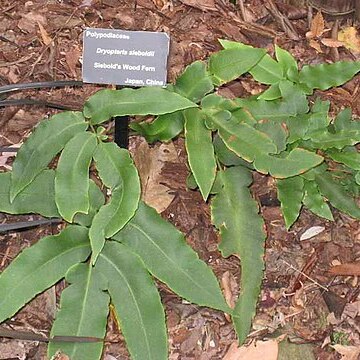Plants 0.5-1 m tall. Rhizome erect, short, stout; scales of rhizome and lower part of stipe dense, pale brown, lanceolate. Fronds caespitose; stipe dark stramineous or ferruginous, 20-60 cm × 2-5 mm, subglabrous upward; lamina oblong or deltoid-ovate, 25-40 × ca. 20 cm, once imparipinnate; pinnae 1-4 pairs, broadly lanceolate or oblong-lanceolate, 15-20 × 2.5-3.5(-6) cm, base rounded or rounded-cuneate, slightly inequilateral, shortly stalked, apex acuminate, terminal pinna similar but larger and with longer stalks than lower pinnae, pinnae entire or incised-serrate. Lamina thickly leathery, glabrous adaxially, rarely with filiform scales; veins indistinct, pinnate, veinlets simple or forked, 4-6 in pinnate groups, basal one of each group at distal side shorter, remainder extending toward margin. Sori abaxial in middle of veinlets, in 3 or 4 irregular rows along both sides of costa; indusia reniform, entire.
More
A fern. It grows 50 cm high and spreads 50 cm wide. The fronds are large and have leaflets along the stalk. There are 5-7 leaflets. These are blue-green in colour. The leaflets are oblong or sword shaped. The edges are irregular with fine teeth. The fertile fronds are larger.

